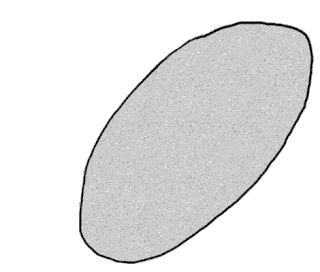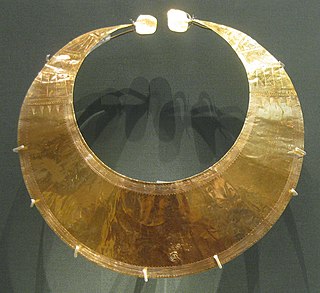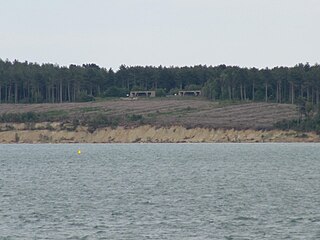
A microlith is a small stone tool usually made of flint or chert and typically a centimetre or so in length and half a centimetre wide. They were made by humans from around 35,000 to 3,000 years ago, across Europe, Africa, Asia and Australia. The microliths were used in spear points and arrowheads.

In archaeology, a hammerstone is a hard cobble used to strike off lithic flakes from a lump of tool stone during the process of lithic reduction. The hammerstone is a rather universal stone tool which appeared early in most regions of the world including Europe, India and North America. This technology was of major importance to prehistoric cultures before the age of metalworking.

In archaeology, in particular of the Stone Age, lithic reduction is the process of fashioning stones or rocks from their natural state into tools or weapons by removing some parts. It has been intensely studied and many archaeological industries are identified almost entirely by the lithic analysis of the precise style of their tools and the chaîne opératoire of the reduction techniques they used.

A stone tool is, in the most general sense, any tool made either partially or entirely out of stone. Although stone tool-dependent societies and cultures still exist today, most stone tools are associated with prehistoric cultures that have become extinct. Archaeologists often study such prehistoric societies, and refer to the study of stone tools as lithic analysis. Ethnoarchaeology has been a valuable research field in order to further the understanding and cultural implications of stone tool use and manufacture.

Crotales, sometimes called antique cymbals, are percussion instruments consisting of small, tuned bronze or brass disks. Each is about 10 cm (4 in) in diameter with a flat top surface and a nipple on the base. They are commonly played by being struck with hard mallets. However, they may also be played by striking two disks together in the same manner as finger cymbals, or by bowing. Their sound is rather like a small tuned bell, only with a much brighter sound, and a much longer resonance. Like tuned finger cymbals, crotales are thicker and larger; they also have slight grooves in them. The name comes from the Greek crotalon, for a castanet or rattle.
In archeology, a uniface is a specific type of stone tool that has been flaked on one surface only. There are two general classes of uniface tools: modified flakes—and formalized tools, which display deliberate, systematic modification of the marginal edges, evidently formed for a specific purpose.

A cumdach or book shrine is an elaborate ornamented metal reliquary box or case used to hold Early Medieval Irish manuscripts or relics. They are typically later than the book they contain, often by several centuries. In most surviving examples the book comes from the peak age of Irish monasticism before 800, and the extant cumdachs date from after 1000, although it is clear the form dates from considerably earlier. The majority are of Irish origin, with most surviving examples now in the National Museum of Ireland ("NMI").
The Paleo-Arctic Tradition is the name given by archaeologists to the cultural tradition of the earliest well-documented human occupants of the North American Arctic, which date from the period 8000–5000 BC. The tradition covers Alaska and expands far into the east, west, and the Southwest Yukon Territory.

The Stowe Missal, which is, strictly speaking, a sacramentary rather than a missal, is a small Irish illuminated manuscript written mainly in Latin with some Old Irish in the late eighth or early ninth century, probably after 792. In the mid-11th century it was annotated and some pages rewritten at Lorrha Monastery in County Tipperary, Ireland. Between 1026 and 1033 the manuscript was encased within a protective cumdach, which was refurbished and embellished a number of times in the late medieval period, in particular before 1381, the year of death of Pilib O'Ceinneidigh, Lord of Ormond, who then had possession of the shrine.

The prehistory of the County of Norfolk, England is broken into specific time periods.

The prehistory of Ireland has been pieced together from archaeological evidence, which has grown at an increasing rate over the last decades. It begins with the first evidence of permanent human residence in Ireland around 10,500 BC, though an earlier date of 31,000 BC, for perhaps temporary hunting incursions, has been suggested following a 21st-century reexamination of a butchered reindeer bone discovered in 1905 at Castlepook Cave, County Cork, and finishes with the start of the historical record around 400 AD. Both the beginning and end dates of the period are later than for much of Europe and all of the Near East. The prehistoric period covers the Palaeolithic, Mesolithic, Neolithic, Bronze Age and Iron Age societies of Ireland. For much of Europe, the historical record begins when the Romans invaded; as Ireland was not invaded by the Romans its historical record starts later, with the coming of Christianity.

The Gold lunula is a distinctive type of late Neolithic, Chalcolithic or early Bronze Age necklace or collar shaped like a crescent moon. They are normally flat and thin, with roundish spatulate terminals that are often twisted to 45 to 90 degrees from the plane of the body. Gold lunulae fall into three distinct groups, termed Classical, Unaccomplished and Provincial by archaeologists. Most have been found in Ireland, but there are moderate numbers in other parts of Europe as well, from Great Britain to areas of the continent fairly near the Atlantic coasts. Although no lunula has been directly dated, from associations with other artefacts it is thought they were being made sometime in the period between 2200–2000 BC; a wooden box associated with one Irish find has recently given a radiocarbon dating range of 2460–2040 BC.

Bouldnor Cliff is a submerged prehistoric settlement site in the Solent. The site dates from the Mesolithic era and is in approximately 11 metres (12 yd) of water just offshore of the village of Bouldnor on the Isle of Wight in the United Kingdom. The preservation of organic materials from this era that do not normally survive on dry land has made Bouldnor important to the understanding of Mesolithic Britain, and the BBC Radio 4's Making History programme described it "probably Europe's most important Mesolithic site" albeit concealed under water.

Crotal bells are various types of small bells or rattles. They were produced in various Pre-Columbian cultures. In Europe they were made from probably before the early Middle Ages and though many founders cast bells of this type, the Robert Wells bell foundry of Aldbourne, Wiltshire, produced the largest range. The first medieval designs came in two separate halves into which a metal pea was introduced and the two halves were then soldered or crimped together. Somewhere around 1400 they were cast in a single piece with a ball of metal inside.

Evidence of human activity during the Mesolithic period in Irish history has been found in excavations at the Mount Sandel Mesolithic site in the north of the island, cremations on the banks of the River Shannon in the west, campsites at Lough Boora in the midlands, and middens and other sites elsewhere in the country.

The Celtic brooch, more properly called the penannular brooch, and its closely related type, the pseudo-penannular brooch, are types of brooch clothes fasteners, often rather large; penannular means formed as an incomplete ring. They are especially associated with the beginning of the Early Medieval period in the British Isles, although they are found in other times and places—for example, forming part of traditional female dress in areas in modern North Africa.

The National Museum of Ireland – Archaeology is a branch of the National Museum of Ireland located on Kildare Street in Dublin, Ireland, that specialises in Irish and other antiquities dating from the Stone Age to the Late Middle Ages.

Mooghaun is a late Bronze Age hill fort located in County Clare, Ireland. It is a well preserved, recently excavated site, occupying an entire hill with wide views of the surrounding lands. Believed to be the largest hill fort in Ireland, it is one of the region's main tourist attractions.

Belderrig is a small village on the North Mayo coast, and lies within the Céide Fields complex, a prehistoric landscape of field systems and related domestic and ritual structures dating to the Neolithic and Bronze Age. The excavations at Belderrig were initiated by Graeme Warren, School of Archaeology, University College Dublin, Ireland, after visiting the site in 2003 with its discoverer, the archaeologist Seamas Caulfield.

A house-shaped shrine is an early medieval portable metal reliquary formed in the shape of the roof of a rectangular building. Most date from the 8th or 9th centuries and consist of a wooden core covered with silver and copper alloy plates. They were intended to hold relics of saints or martyrs from the early Church era; a number held corporeal remains when found in the modern period, presumably they were parts of the saint's body. Others, including the Breac Maodhóg, held manuscripts associated with the commemorated saint. Like many Insular shrines, they were heavily reworked and embellished in the centuries following their initial construction, often with metal adornments or figures influenced by Romanesque sculpture.



















